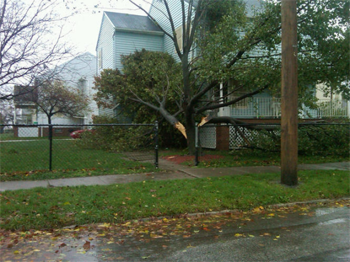 Super Storm Sandy slammed the East Coast and continued to many Midwest States and Canada this fall and did tremendous damage to all types of property. The heavy rains and high winds downed thousands of trees in its path. The evergreen trees and shrubs took a beating with many of them being shallow rooted and were blown all or partially to the ground. Many of these trees and shrubs can be saved, below are a few landscaping tips to handle the damage.
Super Storm Sandy slammed the East Coast and continued to many Midwest States and Canada this fall and did tremendous damage to all types of property. The heavy rains and high winds downed thousands of trees in its path. The evergreen trees and shrubs took a beating with many of them being shallow rooted and were blown all or partially to the ground. Many of these trees and shrubs can be saved, below are a few landscaping tips to handle the damage.
The first thing to do is to check out the damage
If the plant has little root or branch damage it is probably cheaper to right the plant and stake it. Some trees will be too large and others will not fill out after damaged plants are removed. The best thing to do then is to cut up the tree or shrub and remove the root system. The best way to remove the roots is with a stump grinder. Those can be rented at a local rental or hardware store.
If the plants are in good shape several steps should be taken. If the tree roots are out of the ground, time should be taken to dig a hole so the tree roots can go back in place were they came from. Once the tree is upright and secured soil and mulch should be placed over the roots tamped and covered with mulch.
Staking can be done in several ways:
- The cross stake can be used on smaller trees and plants. This stake can be made of a 2” x 2” wooden stake or some type of metal. Once the plant is straight the stake should be pounded in deep at a 45 degree angle so it crosses the plant while it is straight. A steel wire placed through a rubber hose and then wrapped around the trunk of the plant and then the stake and then twisted tightly to secure the plant to the stake.
- The larger trees and shrubs should be staked with three or more guy wires. Metal multi-strand wire is probably the best to use for the larger plants. An eyelet lag bolt should screwed into the trunk of the tree about two thirds up from the ground for each cable. Once the cable goes through the eyebolt a cable clamp should secure it to the main cable. A large 2 to 3 foot auger eyebolt should be screwed into the ground and the cable pushed through the eyebolt whole and clamped back to the main cable. The auger eyebolt stake can be tightened at a later date to keep that cable taught. Most of these materials can be purchased at a local hardware store.


